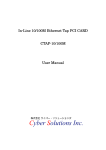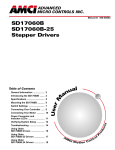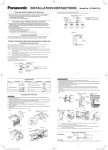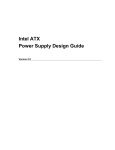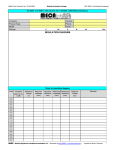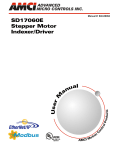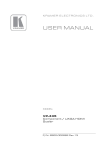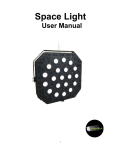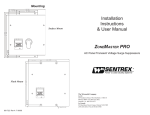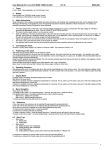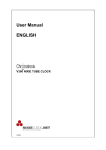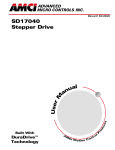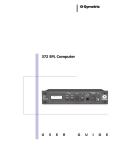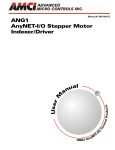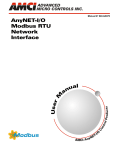Download SD31045 - Advanced Micro Controls Inc
Transcript
ADVANCED MICRO CONTROLS INC. Manual #: 940-0S073 General Information ................. Introducing the SD31045 ......... Specifications ........................... UL/CUL Recognized Installations .............................. Mounting the SD31045 ............ Switch Settings ........................ Connecting Your Controller .... Connecting Your Motor ........... Power Connector and Indicator LED’s ......................... Verifying System Setup ........... Troubleshooting ....................... User M Table of Contents 2 3 4 5 6 7 8 10 11 12 14 ® al u an GENERAL INFORMATION Important User Information The products and application data described in this manual are useful in a wide variety of different applications. Therefore, the user and others responsible for applying these products described herein are responsible for determining the acceptability for each application. While efforts have been made to provide accurate information within this manual, AMCI assumes no responsibility for the application or the completeness of the information contained herein. UNDER NO CIRCUMSTANCES WILL ADVANCED MICRO CONTROLS, INC. BE RESPONSIBLE OR LIABLE FOR ANY DAMAGES OR LOSSES, INCLUDING INDIRECT OR CONSEQUENTIAL DAMAGES OR LOSSES, ARISING FROM THE USE OF ANY INFORMATION CONTAINED WITHIN THIS MANUAL, OR THE USE OF ANY PRODUCTS OR SERVICES REFERENCED HEREIN. No patent liability is assumed by AMCI, with respect to use of information, circuits, equipment, or software described in this manual. The information contained within this manual is subject to change without notice. This manual is copyright 2015 by Advanced Micro Controls Inc. You may reproduce this manual, in whole or in part, for your personal use, provided that this copyright notice is included. You may distribute copies of this complete manual in electronic format provided that they are unaltered from the version posted by Advanced Micro Controls Inc. on our official website: www.amci.com. You may incorporate portions of this documents in other literature for your own personal use provided that you include the notice “Portions of this document copyright 2015 by Advanced Micro Controls Inc.” You may not alter the contents of this document or charge a fee for reproducing or distributing it. Standard Warranty ADVANCED MICRO CONTROLS, INC. warrants that all equipment manufactured by it will be free from defects, under normal use, in materials and workmanship for a period of [18] months. Within this warranty period, AMCI shall, at its option, repair or replace, free of charge, any equipment covered by this warranty which is returned, shipping charges prepaid, within eighteen months from date of invoice, and which upon examination proves to be defective in material or workmanship and not caused by accident, misuse, neglect, alteration, improper installation or improper testing. The provisions of the “STANDARD WARRANTY” are the sole obligations of AMCI and excludes all other warranties expressed or implied. In no event shall AMCI be liable for incidental or consequential damages or for delay in performance of this warranty. Returns Policy All equipment being returned to AMCI for repair or replacement, regardless of warranty status, must have a Return Merchandise Authorization number issued by AMCI. Call (860) 585-1254 with the model number and serial number (if applicable) along with a description of the problem. An “RMA” number will be issued. Equipment must be shipped to AMCI with transportation charges prepaid. Title and risk of loss or damage remains with the customer until shipment is received by AMCI. 24 Hour Technical Support Number 24 Hour technical support is available on this product. Start at our website, www.amci.com if you have internet access. Product documentation and FAQ’s are available on the site that answer most common questions. If you require additional technical support, call (860) 583-7271. Your call will be answered by the factory during regular business hours, Monday through Friday, 8AM - 5PM EST. During non-business hours an automated system will ask you to enter the telephone number you can be reached at. Please remember to include your area code. The system will page an engineer on call. Please have your product model number and a description of the problem ready before you call. We Want Your Feedback Manuals at AMCI are constantly evolving entities. Your questions and comments on this manual are both welcomed and necessary if this manual is to be improved. Please direct all comments to: Technical Documentation, AMCI, 20 Gear Drive, Terryville CT 06786, or fax us at (860) 584-1973. You can also e-mail your questions and comments to [email protected] ADVANCED MICRO CONTROLS INC. INTRODUCING THE SD31045 This manual is designed to get you up and running quickly using the SD31045 stepper drive. As such, it assumes you have some basic knowledge of stepper systems, such as the resolution you want run your motor at, and the reasons why you’d want to use Idle Current Reduction and the reasons why you wouldn’t. If these terms or ideas are new to you, we’re here to help. AMCI has a lot of information on our website and we are adding more all the time. If you can’t find what you’re looking for at http:///www.amci.com, send us an e-mail or call us. We’re here to back you up with all of our knowledge and experience. The SD31045 The SD31045 is a micro-stepping drive that’s the latest is AMCI’s growing line of motion control products. It is designed for use with a variety of stepper motors including AMCI’s NEMA 23 through NEMA 42 sized motors. The SD31045 can be programmed to a maximum resolution of 50,800 steps per turn and output a motor current of 1.0 to 4.5ARMS that is programmable in 0.1ARMS increments. Other features of the SD31045 drive include: Anti-Resonance Circuitry Back-EMF Protection Circuity Programmable Idle Current Reduction Programmable Current Loop Gain Programmable Pulse Train Input (Step/Direction or CW/CCW) Programmable Active State for the Disable Input Operates over a wide input voltage range including a nominal 115Vac and 230Vac. The SD31045 is designed for 230Vac operation, but it will also operate at 115Vac. Most specifications and tables in this manual assume 230Vac operation. For example, when operating at 230Vac, the motor bus voltage is 310Vdc, while operation at 115Vac will give you a motor bus voltage of 170Vdc. If your application will only be using 115Vac for power, consider using AMCI’s SD17060B drive. It has exactly the same features as the SD31045, a maximum motor current setting of 6.3ARMS, and it will run more efficiently at 115Vac. 20 Gear Drive, Plymouth Ind. Park, Terryville, CT 06786 Tel: (860) 585-1254 Fax: (860) 584-1973 http://www.amci.com 3 SPECIFICATIONS Drive Type Motor Current Two bipolar MOSFET H-bridges with 310Vdc output bus with a 230Vac input. (170Vdc with 115Vac input). 20KHz PWM current control. Physical Dimensions Width: Depth: Height: Idle Current Reduction Switch selectable to Not reduced, To 69%, To 50%, or To 0%. Motor current is reduced to selected level if a step pulse is not received for one second for the To 50%, and To 0% settings. For the To 69%, setting, current is reduced after 10 milliseconds. Current is restored to full value on next pulse. 2.7 inches max. 4.7 inches max. 6.2 inches 7.0 inches with mounting tabs Weight 2.6 lbs. (1.2 kg.) Resolution Inputs Electrical Characteristics for all Inputs: .............. Differential. 1500 Vac/dc opto-isolated. Can be wired as single ended inputs. Indexer ........ Motor steps on high going pulse. 250 nS min. pulse width, 2 MHz maximum input frequency. 500 nS minimum dwell time between direction changes. Disable ........ Programmable active state (ON or OFF). Disables current to motor. Drive does not accept steps while disabled. Fault Output Electrical Characteristics: Open Collector/Emitter. 1500 Vac/dc opto-isolated. 30Vdc, 20 mA max. The Fault Output is normally on. Turns off under the following conditions: Reset .................. The drive initialization is not yet complete on power up. Short Circuit ...... Motor Phase to Phase or Phase to Earth Ground Over Temp ......... Heat Sink temperature exceeds 90° C (195° F) No Motor ........... The motor interlock terminals are not connected. Pulse Train Input Switch selectable to CW/CCW or Step/Direction. 4 Switch selectable from 1.0 to 4.5Arms in 0.1 Amp steps. Switch selectable to 200, 400, 1,000, 2,000, 5,000, 10,000, 12,800, 18,000 20,000, 21,600, 25,000, 25,400, 25,600, 36,000, 50,000, or 50,800 steps per turn. Internal Power Fuses 10 Amp Slow Blow. Both Line and Neutral are fused. Fuses are not user replaceable. Environmental Specifications Input Power ............ 95 to 264Vac, 50/60 Hz, 5.0 Apk max. Drive will retain control of motor down to 85Vac at reduced torque. Ambient Operating Temperature ........... -4° to 122°F (-20° to 50°C) Storage Temperature ........... -40° to 185°F (-40° to 85°C) Humidity .............. 0 to 95%, non-condensing Motor Specifications Type .............. 2 phase hybrid. 4, 6, or 8 lead motor Insulation ...... Minimum 500Vdc phase-to-phase and phase-to-case Inductance ..... 0.3 mH minimum. 2.5 to 45 mH recommended Connectors All mating connectors are included with driver. Connector Wire Strip Length Min. Tightening Torque Indexer 28 - 16 AWG 0.275 inches 1.95 lb-in (0.22 nM) Motor 24 - 12 AWG 0.275 inches 4.43lb-in (0.5 nM) Power 24 - 12 AWG 0.275 inches 4.43lb-in (0.5 nM) ADVANCED MICRO CONTROLS INC. UL/CUL RECOGNIZED INSTALLATIONS The SD31045 is an Underwriter Laboratory Inc.® listed device. It is listed as “Industrial Control Equipment” under the control number 60GB. The UL file number is E231137. The SD31045 is appropriate for UL and CUL applications. UL Required Information If your installation is to meet UL requirements, you must be aware of the following information when using the SD31045. Maximum surrounding air temperature is +50°C The SD31045 does not incorporate internal motor overload protection. The SD31045 does not provide motor over temperature protection. The SD31045 does not provide overspeed protection. The SD31045 shall be used in pollution degree 1 or 2 environments. If the SD31045 is mounted in an enclosure, this enclosure must meet these requirements. All wiring to the SD31045 shall be R/C (AVLV2), minimum rating of 80°C, 300V, except secondary low-voltage circuit wiring. Use 75°C copper conductors only. Terminals shall be tighten to manufacturer’s recommended torques Power Connector shall be rated for a minimum 12A, 600V, in a pollution degree 2 environment† Motor Connector shall be rated for a minimum 16A, 600V, in a pollution degree 2 environment† I/O Connector shall be rated for a minimum 8A, 300V, in a pollution degree 2 environment† † The mating connectors that are supplied with the SD31045 meet these requirements. Additional mating connectors can be ordered from AMCI under the part number AK-17060. 20 Gear Drive, Plymouth Ind. Park, Terryville, CT 06786 Tel: (860) 585-1254 Fax: (860) 584-1973 http://www.amci.com 5 MOUNTING THE SD31045 Outline Drawing 2.67" (67.8) 0.152" (3.86) dia. DIR/CCW DIR/CCW STEP/CW STEP/CW INTERLOCK INTERLOCK POWER GND AC POWER 95 – 264 VAC 50/60 Hz N L 0.60" (15.2) 4.00" (101.6) 0.70" (17.8) max. Total clearance of 3.0" (76.2) needed for Connector installation and removal. #10-32 UNF-2B. Two places. Min. screw length = 0.31" (7.9) + thickness of mounting panel. Max. screw length = 0.62" (15.8) + thickness of mounting panel. Mounting Methods There are two ways to mount the SD31045. The first method is with two #10-32 screws into the back panel. The second method is by the mounting tabs. Mounting tabs are for #6 screws. When using the back panel mounting method, minimum and maximum screw lengths should be observed to prevent a screw from shorting to the PC Board or components. There are airflow holes in the top and bottom of the enclosure. To ensure adequate convectional airflow, the drive must be mounted in the orientation shown in the drawing. To ensure adequate airflow and wiring space, you need two inches (50 mm) of space above and below the drive, one and one-half inches (37 mm) of space to the left and right of the drive, and one inch (25 mm) of space in front of the drive. These dimensions are typical for convectional cooling. If you have an active cooling system such as enclosure fans, you will be able to mount the drives closer together. Grounding The SD31045 must be grounded for proper operation. The GND connection on the power connector is connected to the SD31045 enclosure and is a sufficient grounding point for most applications. A grounding lug is also available. AMCI strongly suggests using heavy gauge stranded wire or wire braid when using the grounding lug. Avoid using solid wire. When mounted the SD31045 on a surface that is electrically conductive and grounded, you should also take steps to ensure that the two are electrically bonded together. If necessary, remove paint from the bolt mounting surfaces of the panel to ensure adequate electrical bonding. 6 ADVANCED MICRO CONTROLS INC. SWITCH SETTINGS The SD31045 is configured by DIP switches on the top of the driver. The factory default setting has all switches in their off (0) position except for SB2-1. (Current Loop Gain = 1) All switch setting are latched. You must cycle power to the driver before changes take effect. Note on Idle Current Reduction SB3 SB4 SWITCH SETTINGS PULSE TRAIN INPUT CW/CCW IDLE CURRENT REDUCTION NO REDUCTION Disable Input You can configure the Disable Input's active state. When Active High, you must apply power to the input to disable the driver. When Active Low, you must apply power to the input to enable the driver. If you are not using the input, set this switch to Active High and the driver will operate as you expect. When the Disable Input is active, the SD31045 removes power from the motor and stops accepting indexer pulses. Over-temp and Over-current faults are cleared when the driver transitions from a Disabled state. Anti-Resonance Allows the SD31045 to compensate for back-EMF generated by the motor. It should be left enabled for most applications. Disable only if you are sure you do not want this feature or under the advice of AMCI tech support. Current Loop Gain SB2 RESOLUTION DISABLE INPUT ACTIVE STATE (Steps / Revolution) ACTIVE LOW ANTI-RESONANCE CURRENT LOOP GAIN Gain = 1 Gain = 2 Gain = 3 Gain = 4 Gain = 5 Gain = 6 Gain = 7 Gain = 8 Gain = 9 Gain = 10 Gain = 11 Gain = 12 Gain = 13 Gain = 14 Gain = 15 Gain = 16 Gain = 17 Gain = 18 Gain = 19 Gain = 20 Gain = 21 Gain = 22 Gain = 23 Gain = 24 Gain = 25 Gain = 26 Gain = 27 Gain = 28 Gain = 29 Gain = 30 Gain = AutoMode This setting allows you to compensate for variations in motor properties which will give you smoother motion and better positional accuracy. See the Setting the Current Loop Gain section on page 12 for more information. Self-Test Mode Self-Test mode is controlled by the switch SB4-1. If you change the state of this switch while power is applied to the SD31045, the driver will respond by rotating the attached motor clockwise at 60 RPM with a resolution of 50,000 steps per turn. Note that changing this switch does not alter the current supplied to the motor. All switch settings are read and latched on power up. However, you must return this switch to its correct setting for normal operation before cycling power or resetting the SD31045. 20 Gear Drive, Plymouth Ind. Park, Terryville, CT 06786 Tel: (860) 585-1254 Fax: (860) 584-1973 http://www.amci.com 1.0 1.0 1.0 1.0 1.0 1.0 1.0 1.0 1.0 1.0 1.0 1.1 1.2 1.3 1.4 1.5 1.6 1.7 1.8 1.9 2.0 2.1 2.2 2.3 2.4 2.5 2.6 2.7 2.8 2.9 3.0 3.1 3.2 3.3 3.4 3.5 3.6 3.7 3.8 3.9 4.0 4.1 4.2 4.3 4.4 4.5 4.5 4.5 4.5 4.5 4.5 4.5 4.5 4.5 4.5 4.5 4.5 4.5 4.5 4.5 4.5 4.5 4.5 4.5 7 OUTPUT CURRENT The SD31045 controls the RMS current through the motor. Therefore it can momentarily put 1.4 times the motor's rated current through the windings safely. If you choose a setting of No Reduction, the SD31045 will revert to peak current control when the motor is not turning. This feature protects the motor from damage. You will not see a reduction in holding torque. SB1 ON CONNECTING YOUR CONTROLLER I/O Connector The I/O connector on the SD31045 accepts inputs from your indexer as well as the Disable Input and Fault Output. All inputs accept 5Vdc differential signals and can also be wired to accept single ended sinking or sourcing inputs of up to 24Vdc without the need of an additional current limiting resistor. DIR/CCW + DIR/CCW STEP/CW + STEP/CW DISABLE + DISABLE FAULT + FAULT Indexer Inputs Disable Input Fault Output Input Wiring All inputs on the SD31045 are low voltage, low power signals. All wiring should use shielded, twisted pair cable such as Belden 9727 instrumentation cable. The shield of the cable should be grounded at one end only, preferably at the indexer or controller. Do not ground the shields at the SD31045. If you must splice the cable, do not connect the shields to the ground of the junction box. Indexer Inputs These inputs can be programmed to accept Step & Direction or CW/CCW pulses. This setting is controlled by SB1-1. Disable Input When active, the motor current is off and the driver does not accept indexer pulses. The active state of the Disable Input is set by switch SB1-4. RLD An additional load resistor may be required on some PLC outputs to improve switching time. A symptom of this problem is that the motor will begin to run rough at high speeds. A 470 or 560 ohm resistor should be used. For 5V and 12V systems use a 1W resistor. For 24V systems use a 2W resistor. These power ratings assume that the output can be normally on. For systems where you are sure the output is always normally off, the wattage ratings can be cut in half. 8 ADVANCED MICRO CONTROLS INC. CONNECTING YOUR CONTROLLER Output Wiring The ±Fault Output is an optically isolated transistor capable of driving a typical PLC input. The Fault Output is normally on (conducts current) and turns off under the following conditions: The Interlock jumper is missing on the motor connector There is a short in the motor, either phase to phase or phase to ground The heatsink temperature exceeds 90°C (195°F) The driver is in its reset state and is not ready to accept pulses Both ends of the output are uncommitted, so it can be wired as a sourcing or sinking output. The figure shows a typical connection as a sourcing output. Open Collector Sourcing Output RLIMIT* Shielded, Twisted Pair Cable VDC max: 30Vdc 20 mA VCESAT: 1Vdc @ 20 mA Power Dissipation: 20 mW max. RLIMIT A resistor may be needed to limit the current through the Fault Output. The value, and power rating of the resistor is dependent on the value of Vdc, the voltage drop across the input, and the current requirements of the input. 20 Gear Drive, Plymouth Ind. Park, Terryville, CT 06786 Tel: (860) 585-1254 Fax: (860) 584-1973 http://www.amci.com 9 CONNECTING YOUR MOTOR Compatible Motors The SD31045 will work with many different motors, including those not sold by AMCI. This section assumes that you have already chosen your motor and you are looking for wiring information. No wire colors are given because there is no single industry wide color coding standard for stepper motor wires. You must refer back to your motor data sheets for this information. AMCI offers several different stepper motors in sizes 23 and 34. Refer to our website, www.amci.com, for additional information on these products. Motor Wiring Eight Lead Series Connected Eight Lead Parallel Connected INTERLOCK B CTAP B B EARTH GND A A A CTAP INTERLOCK Six Lead Series Connected B Six Lead Center Tap Connected 6 LEAD MOTOR B B B A A A A Four Lead Connected B 4 LEAD MOTOR B A A 6 LEAD MOTOR 1) The Interlock jumper is a safety device that is needed for proper operation. The SD31045 will not power the motor without this jumper. When the jumper is installed, up to 310Vdc is present on the connector. Do not use the Interlock for anything other than its intended use as a safety device. 2) Refer to the torque vs. speed curves on your motor's specifications sheet to determine if you should wire the motor to the SD31045 in series, parallel, or centertap configuration. The two center tap pins on the drive are electrically isolated and are for wiring convenience only. Reversing the ±B connections will reverse the motor's direction of rotation. 10 3) ADVANCED MICRO CONTROLS INC. POWER CONNECTOR AND INDICATOR LED’s Power Connector The SD31045 operates on input voltages from 95 to 264 Vac. If 115Vac is the only power available, you have the option of using one of the 115 Vac drivers available from AMCI. Information on these drivers can be found on our website, http://www.amci.com. The SD31045 must be grounded for proper operation. Grounding is accomplished with the GND pin on the power connector, and through proper bonding to the enclosure. Power connections should be tight. Loose connections may lead to arcing which will heat the connector. Phoenix Contact specifies a tightening torque of 4.4 to 5.4 lb-in (0.5 to 0.6 Nm) GND AC POWER 95 – 264 VAC 50/60 Hz N L Indicator LED’s The SD31045 has two indicator LED’s. STEP/FAULT Green: Driver Operational Flashing Green: Driver Operational, Receiving Pulses Red: Driver Fault (The Over Temperature and Over Current faults can be cleared with the Disable Input.) 1) Over Temperature Fault: The heatsink temperature exceeds 90°C (195°F) 2) Over Current Fault: Generally, a short exists somewhere in the system. This can be a short in the motor or in the driver itself. A)Phase–Phase Short:There is an electrical short between the two motor windings. The short exists in the motor cable or in the motor itself. B)Phase–Ground Short:One of the motor’s windings is shorted to earth ground. (The EARTH GND terminal of the Motor Connector is used as the reference point.) The fault can be in the motor cable or in the motor itself. C)Back EMF:In applications with large motors and high deceleration rates, back-EMF generated by the motor may also cause this fault. 3) Interlock Fault: The two Interlock Terminals on the motor connector are not connected with a short jumper. Flashing Red: Current Loop Gain AUTOID Error. There is a problem with the motor wiring or the motor current is set to zero. Flashing Red/Green @ 1Hz: Step Violation: The indexer sent step pulses to the SD31045 before the driver was ready for them. The driver was disabled, in a fault condition, or had not completed its initialization sequence on power up or reset. The stepper motor position will be invalid. The motor is not disabled and can still be driven. While there is motion, the LED will flash at approximately 4 Hz. CURRENT LOOP GAIN: This LED is also used when the Current Loop Gain is set to AutoID. (SB2:1- 5 all turned off) When set to AutoID, the driver will determine the parameters of the attached motor on power up and will flash the Step/Fault LED green the number of times that the parameter should be set to. Flashing red indicates a problem with the motor wiring or the motor current is set to zero. Further information can be found in the next section of the manual, Verifying System Setup. Power Green: Power is applied to the driver in the range of 95 or 264 Vac. 20 Gear Drive, Plymouth Ind. Park, Terryville, CT 06786 Tel: (860) 585-1254 Fax: (860) 584-1973 http://www.amci.com 11 VERIFYING SYSTEM SETUP Setting the Current Loop Gain Setting the Current Loop Gain correctly allows you to maximize your motor’s performance. The SD31045 takes into account the line voltage, output current and motor impedances when determining the optimum gain for your system. Assuming a stable line voltage, the following gains should be used for AMCI motors. These gain settings are averaged values based on a large sample of motors. Your system may benefit from increasing or decreasing these settings. In general, increase the setting by one or two counts to improve high speed performance or decrease the settings for quieter low speed operation. 230 V ac GAIN SETTINGS MOTOR CURRENT MOTOR PART # SM2340-130 SM2340-240 SM34-450 SM34-850 SM34-1100 SM23-130 (Series) SM23-130 (Parallel) SM23-240 (Series) SM23-240 (Parallel) SM42-1800 1A 2 3 1.5 A 3 4 2A 3A 4A 1 2 3 6 8 3 1 5 2 1 3 4 7 9 1 3 5 8 10 1 1 3 5 3 6 4.5A 7 115 V ac GAIN SETTINGS MOTOR PART # MOTOR CURRENT SM2340-130 SM2340-240 SM34-450 SM34-850 SM34-1100 SM23-130 (Series) SM23-130 (Parallel) SM23-240 (Series) SM23-240 (Parallel) SM42-1800 1A 1.5 A 4 6 6 8 2A 3A 4A 2 4 6 11 12 7 2 10 4 3 5 9 14 17 4 6 11 17 21 3 4 5 10 6 11 4.5A 12 If you are using a non-AMCI motor, use the following procedure to determine the correct gain for your system. The SWITCH SETTINGS section on page 7 should be used to verify switch settings. 1) Turn off all of the switches in switch bank SB2. This configures the Current Loop Gain setting to its “AutoID” value. 2) Verify that the motor current is set correctly. (Switch SB3-5 and switch bank SB4.) 3) Verify that the motor is attached to the driver. 4) Cycle power to the driver. The STEP/FAULT LED will begin to blink almost immediately. Count the number of blinks. This number is what you should initially set the Current Loop Gain to. (continued on next page) 12 ADVANCED MICRO CONTROLS INC. VERIFYING SYSTEM SETUP Setting the Current Loop Gain (continued) 5) Set the switches in SB2 to equal the number of times the STEP/FAULT LED blinked. 6) Cycle power to the SD17060B and verify motor operation using the System Checkout procedure below. If need be, adjust the Current Loop Gain settings up or down depending on your application. In some cases, the Current Loop Gain can be set to its AutoMode setting and the SD17060B will automatically determine the proper gain on every power up or reset. This procedure is done in under two seconds. The Current Loop Gain’s AutoMode setting, though convenient, should be used with caution. Changes in the system while the gain is being measured, such as a change in line voltage, or noise being injected into the motor cable, can force the drive to set the gain to an incorrect value. This can lead to a system that appears to randomly fail when power is cycled to the drive. AMCI strongly suggests using the above procedure to set the gain to a fixed value whenever possible. System Checkout 1) Verify all wiring and grounding before applying power to the SD31045. Make sure the rubber boots are on the driver’s motor and power connectors. 2) Apply 115Vac power. With the motor attached, the power and status LED’s should come on green. A problem exists if either LED does not light, or the Status LED is red. Remove power and refer to the Troubleshooting section of this manual which begins on the following page. 3) Check for holding torque on the motor. If you have less then you expected, the most common causes are improper motor current switch settings or having the Idle Current Reduction turned on. 4) The Self-Test feature of the SD31045 allows you to verify your motor wiring without an indexer. With power applied to the driver, toggle the SB4-1 switch. The motor will begin to rotate clockwise at 60 RPM. You must remove power from the driver to stop the rotation. If the motor rotates in the counter-clockwise direction, swap the +B and –B connections. If the motor does not rotate at all, verify your current setting and the motor’s wiring. 5) Have your indexer make a slow move in the clockwise direction for one turn. While the turn is in progress, the STEP LED should blink. Verify that the motor rotated in the correct direction for one complete turn. If you are using an optical encoder or other position feedback, verify that the indexer or controller is reading it properly. 6) Repeat step 5 with a one turn move in the counter-clockwise direction. Again verify that the motor rotated in the correct direction for one turn. Any failures at steps 5 or 6 are usually caused by not setting the Pulse Train Input switch correctly or programming the wrong number of pulses in the indexer profile. If the motor rotates in the wrong direction you can swap the +B and –B connections instead of altering your programming. 7) If you are using the Disable Input, verify its operation with the motor stopped. Note that the motor will have no holding torque while this input is active and the motor’s shaft will be free to rotate. 8) If you are using the Fault Output, verify that it is On (conducting). Remove power from the SD31045, disconnect the motor, and re-apply power. The STEP/FAULT LED should be red and the Fault Output should be off (not conducting). 9) Remove power and re-attach the motor. Power the driver. 10) Consider altering the motor current or enabling the Idle Current Reduction if it is not already enabled. Lowering the motor current or enabling Idle Current Reduction can greatly reduce motor heating. 20 Gear Drive, Plymouth Ind. Park, Terryville, CT 06786 Tel: (860) 585-1254 Fax: (860) 584-1973 http://www.amci.com 13 TROUBLESHOOTING Indexer Problems Symptom Solution My indexer/PLC reports a fault from the SD31045 when everything seems fine. Your logic may be reversed. On the SD31045, the Fault Output is on (conducts current) when the drive is working correctly and turns off (stops current flow) when there is a fault with the drive. Therefore, losing power to the drive appears as a fault. If you’re expecting the fault output to turn on and conduct current when there is a fault, then your logic is reversed. The motor is running faster/ slower than expected and/or the distance traveled is father/ shorter than expected. Most likely a problem with the SD31045’s Step Resolution setting or the indexer’s programming. If the motor is running too fast, the Step Resolution on the SD31045 is set lower than the indexer’s programmer assumed it would. If the motor is running slow, the Step Resolution is set higher than the indexer programmer assumed it would be. Drive Problems Symptom Solution Both LED’s are off, and the Fault Output is active. (Not conducting) Power is applied to the drive. 1) The AC line voltage may be too low. It must be greater than 95Vac for the SD31045 to operate properly. 2) One or both of the 10A fuses may be blown. These fuses will not blow under normal circumstances, so call AMCI for assistance. Blown fuses may be a sign of serious installation problems. Both LEDs are green, the Fault Output is inactive, (conducting) but the motor is not powered. 1) The ±Disable input may be active. The active state, (power applied or power removed), is set by DIP switch SB1-4. This switch may be set incorrectly. 2) The Idle Current Reduction may be set to its To 0% setting. With this setting, current is removed from the motor if a directional pulse is not received for one second. The STEP/FAULT LED does not blink when the indexer sends pulses to the drive. The motor does not turn. 1) Verify that your two directional inputs on the Indexer Connector are not swapped or cross-wired. 2) If the inputs are wired as a sinking or sourcing instead of differential, verify that the proper current limiting resistor is installed and that they are wired correctly. If your indexer has sourcing outputs, then the inputs of the SD31045 must be wired as sinking inputs and vice versa. The STEP/FAULT LED is red. The drive is experiencing a fault condition. All faults are latched, so power must be cycled to the drive or the Disable Input must be toggled before the fault will clear. 1) Over Temp Fault. Is the drive very hot? It shuts down when its internal temperature exceeds 90°C (195°F). 2) Interlock Fault. The motor is not plugged into the drive or a wire jumper was not installed between the two Interlock pins on the Motor Connector. 3) Short in Motor. Shut off the SD31045 and disconnect the motor. Pull back the rubber boot and verify the following with an ohmmeter. a) Open circuit from “A+” to “B+” pins. (Tests for short between phases.) b) Open circuit from “A+” to “Earth Ground” and “B+” to “Earth Ground”. (Tests for short between phase and case.) If any of these readings is not an open circuit, then check your wiring. The most common cause of a short between phases is crosswiring the phases when wiring the connector. If you see a phase-tocase short, make sure you don’t have a stray wire from the “B+” or “A-” terminals hitting the Earth Ground terminal on the connector. 14 ADVANCED MICRO CONTROLS INC. TROUBLESHOOTING Motor Problems Symptom Solution The motor has no holding torque. 1) If the Step/Fault LED is red, then a problem exists with the drive or motor. Refer to Power Connector and Indicator LED’s on page 11 for information. 2) If the motor rotates when commanded but has no holding torque, then your Idle Current Reduction switch is set to the To 0% setting. This setting removes motor current when the drive is idle for more than one second. There are other idle current reduction settings available. See Switch Settings on page 7 for more information. 3) The SD31045 ships with the motor current set to its minimum value of 1.0 amp. It’s possible that it was not set for your application. See Switch Settings on page 7 for the proper switch settings. The SD31045 blinks its STEP/ FAULT LED green when pulses 1) The acceleration or starting speed values may have been set too high when the indexer was programmed. The motor may start to accelerate and stall as the acceleration increases. 2) The Step Resolution may be set to a values lower than you are expecting. For example, if the Step Resolution is set to 200 instead of 400, the acceleration value is effectively doubled. are applied to the drive, but the motor only emits a high pitch noise. It does not rotate. The motor only runs in one direction. This problem is usually caused by the directional pulse inputs. If your indexer is sending pulses in the CW/CCW format and the drive is configured for the Step & Direction format, the motor will rotate counterclockwise when the drive receives CW pulses, and it will not rotate at all when the drive receives CCW pulses. If the indexer is sending pulses in the Step & Direction format and the drive is configured for the CW/CCW format, the motor will only rotate clockwise, even when the indexer is commanding a counter-clockwise move. The motor runs backwards. (CW instead of CCW and/or CCW instead of CW) 1) One of the motor phases may be reversed. The “quick fix” is to reverse the connections on the ±B windings. 2) There may be a problem with the directional inputs. Either they are wired incorrectly or the format is wrong. Check wiring and see the previous problem for more information on problems with format. As its running speed increases, the motor begins to run rough, and eventually stops while pulses are being applied. 1) If you are using single ended outputs for your pulse and direction signals, you may have a problem with the outputs not switching fast enough. See the note on the RLD Resistor in the Connecting Your Indexer section on page 8. 2) You may have a problem with resonance in the system. Run the system with the Anti-Resonance feature enabled and disabled to see which give you better performance. The Anti-Resonance feature is set with SB1-5. See page 7 for more information. The motor runs erratically. 1) The motor is not correctly coupled to the load. 2) The deceleration rate is set to high and the inertia of the load is carrying the motor past the point where it is supposed to stop. 3) You are performing a slow move, (under 1 revolution/second) while the Step Resolution is set to 200 or 400 steps/turn. To correct this problem, try increasing the indexer’s starting speed parameter. Do not increase the starting speed beyond your slowest running speed. 4) The motor current is set too low and the motor is unable to move the load. 5) The motor is not correctly wired. Eight lead motors can be wired in series or parallel. Series connection gives you more torque at lower speeds and parallel connection gives you more torque at higher speeds. As noted above, sometimes a problem that appears to be with the motor is actually a problem with the indexer. The SD31045 has a Self-Test feature that allows you to verify motor operation without an indexer. With power applied to the drive, toggle the SB4-1 switch. The motor will begin to rotate clockwise at 60 RPM. You must remove power to the drive to end the self test. Please remember to return SB4-1 to its original position before cycling power to the drive. 20 Gear Drive, Plymouth Ind. Park, Terryville, CT 06786 Tel: (860) 585-1254 Fax: (860) 584-1973 http://www.amci.com 15 ADVANCED MICRO CONTROLS INC. LEADERS IN ADVANCED CONTROL PRODUCTS
















